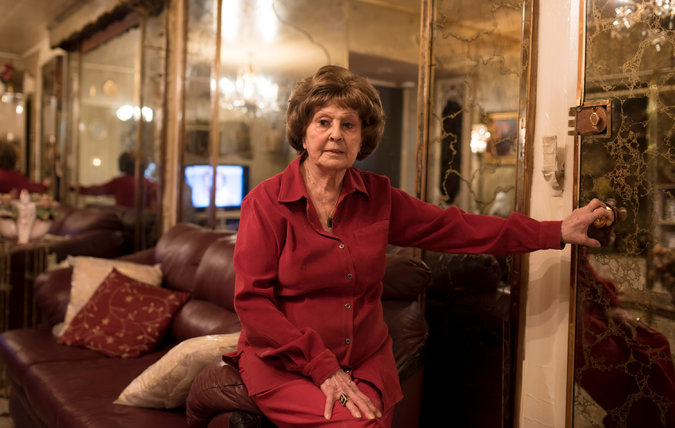
Adele Sarno
In Japan, Adele Sarno would be considered a Living National Treasure but in New York she’s being evicted. An 85 years old Italian-American woman is in the way of the expansion plans of the Italian-American Museum. How’s that for irony?
Two quotes for yesterday’s New York Times that sum up the issue: (the complete article is below)
“You’re fighting a museum that purports to exhibit Italian-American culture and then proceeds to evict a living artifact,” said Victor J. Papa, director of the Two Bridges Neighborhood Council.
“So the museum should be running a charity or providing residences at discount rates?” Joe Carella, the spokesman, asked. “That doesn’t match the mission.”
New York Times – 3/25/15
Museum in Little Italy Seeks to Evict a Living Link to the Past
Adele Sarno’s father, a longshoreman, emigrated from Naples, and she grew up in Manhattan’s Little Italy. As a child, she served as princess for the annual Feast of San Gennaro, she said, and one year was even crowned the queen.
Ms. Sarno eventually owned a candy shop and, later, an Italian products store below her family’s apartment on Grand Street until Sept. 11, when business dried up.
The number of people of Italian ancestry who live in Little Italy is shrinking by the year, and may soon drop by one more: Ms. Sarno, 85, is being evicted from her apartment after losing a fight to keep her $820-a-month rent from skyrocketing. But what has gotten tenant advocates’ attention is not just her age, but also the identity of the landlord: the Italian American Museum, which is in the building next door.
“You’re fighting a museum that purports to exhibit Italian-American culture and then proceeds to evict a living artifact,” said Victor J. Papa, director of the Two Bridges Neighborhood Council, an affordable housing group that has helped Ms. Sarno in her effort to stay. “That’s absolute hypocrisy.”
A spokesman for the museum said ethnicity had nothing to do with it. The museum owns a total of six apartments, including Ms. Sarno’s, in three contiguous tenement buildings at Mulberry and Grand Streets, and relies on the rental income to help pay expenses.
“So the museum should be running a charity or providing residences at discount rates?” Joe Carella, the spokesman, asked. “That doesn’t match the mission.”
Founded in 2001, the Italian American Museum is “dedicated to the struggles of Italian-Americans and their achievements and contributions to American culture and society,” according to the mission statement posted on its website. Ms. Sarno said she was indeed struggling, with a notice from the city marshal giving her only days to leave. She filed a request in housing court this week to halt the eviction.
“How could you throw old people out?” she said on Wednesday, sitting in her apartment, a mini-museum itself furnished with lamps, marble tables and ceramics from the old country. “I’m not going to be here that many more years. Let me die in my home.”
The players in the dispute have added a cultural element to one of the thousands of eviction cases in New York each year. In this case, Ms. Sarno’s two-bedroom unit could fetch five times the current rent in an area that, like many in the city, has become lucrative territory.
Ms. Sarno, whose only child, a daughter, lives in Wisconsin, wants to stay in the neighborhood where she was born by midwife. Her family, including two brothers, a sister and her parents, who eventually separated, all lived in Little Italy. She said she had moved to her current second-floor apartment, where her father was living, after her divorce in the 1960s.
Not much is left of Ms. Sarno’s Little Italy, now mostly a tourist magnet of a few blocks that has been overwhelmed by Chinatown’s sprawl. The 2010 census recorded not one neighborhood resident who had been born in Italy.
“My good friends all passed away,” she said. “I’ve got my television.”
She still counts on a few friends: the owner of the gun shop next door who takes out her garbage; the young couple upstairs who have a baby and pay $4,500 a month; an old boyfriend who drives her to a ShopRite on Staten Island to save on groceries.
Her doctors and the parish where she was baptized, Church of Most Precious Blood, founded in the late 1800s, remain within walking distance.
The museum moved to Little Italy from Midtown Manhattan in 2008, buying the three buildings for $9 million in order to expand. The recession halted those plans, Mr. Carella said, and the goal now is to find a developer to buy the buildings while allowing the museum to remain rent-free.
Ms. Sarno said she got a letter from the museum about five years ago saying that the rent was being raised to $3,500. With Social Security payments and help from relatives as her only sources of income, she said, she could not possibly pay that much.
With the help of Two Bridges Neighborhood Council, she sought a determination from state housing officials about whether her apartment was subject to rent-regulation laws that would protect her. She learned it was not, and after several years of appeals and legal back-and-forth, the museum was allowed to the pursue eviction in November. The notice to vacate followed this month.
Described by neighbors as an independent woman who goes to bed early, wakes up in the middle of the night and cooks pasta in the wee hours, Ms. Sarno said that if she was forced out, her most viable option would be to join her daughter in Wisconsin, taking along her 19-year-old cat, Tosha.
“I don’t want to go there,” she said. “I don’t drive. I’d be stuck in the house 24/7.”
In an interview, Joseph V. Scelsa, founder and director of the museum, rejected the idea that the eviction was at odds with the institution’s mission.
Little Italy, he said, “is not a community of Italian-Americans any longer.” He said at some point the population that gave the area its name would disappear entirely, but that “the legacy would still remain because we have an institution that does that.”
Other promoters of Italian-American culture saw the irony in the situation.
“I would hope they can find some sort of solution for her,” said Anthony Tamburri, dean of the John D. Calandra Italian American Institute at Queens College, where Dr. Scelsa once served as director. “The thought of an 85-year-old having to move to Wisconsin is unsettling to be sure.”

Link to New York Times article – click here
